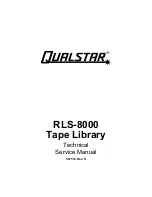
3-1
SECTION 3. THE PRINTER ENABLE METHOD OF DATA STORAGE
Data from the 21X and CR7 with PROMS older than the OSX and OX7 series PROMS and from the
CR21 and DSP4 are stored in the Storage Module via the Printer Enable Method, i.e., data on the TD
line (pin 9) are stored while the PE line (pin 6) is high. This is also the method of data storage with non-
datalogger devices.
The Storage Module defaults to the Printer Enable Method each time it is powered up by 5 VDC applied
to Pin 1 of its 9-pin "D" connector. Up to two Storage Modules can be connected to the 21X, CR7, or
CR21 dataloggers at one time. If two are connected, one should be set to Fill and Stop, and the other
configured as Ring Memory. Storage Module-to-Storage Module dumps are not possible with the Printer
Enable Method.
NOTE: If the PE line is high when power is applied, the SM will not store data until the next time PE
goes high. Also, if power to the SM is interrupted during a transmission, data since the last time PE
went high will be lost.
3.1 BAUD RATES
In the Printer Enable Method, the user must
ensure that the baud rates of the Storage
Module and the datalogger are matched. The
CR21 has a fixed baud rate of 300. Other
Campbell Scientific Inc. dataloggers have
selectable baud rates.
The Storage Module baud rate is software
selectable, and may be set using SMCOM.
Data can be sent to the Storage Module at baud
rates of 300, 1200, 9600, 76,800, and 76,800-
with-9600-fall back.
The 76,800-with-9600-fall back configuration is
the default setting after an SM reset. When in
this setting, the SM can automatically change
from capturing data at 76,800 baud to capturing
data at 9600 baud. This feature allows the use
of two different baud rates in a single program.
The practical application of this would be in a
program which generates both BURST data at
76,800 baud and "normal" data at 9600 baud.
Baud rate errors, i.e., baud rate mismatches
between the datalogger and the Storage Module,
cause the Storage Module to increment its error
counter and enter a low power standby state.
3.2 STORING DATA FROM THE 21X
AND CR7 (ALL VERSIONS PRIOR TO
OSX AND OS7 RELEASE)
Instruction 96 is the recommended method for
the CR7 and the 21X with Extended Software.
The *4 Mode can also be used for this data
transfer but Instruction 96 is more efficient. For
large volumes of data two SMs can be
connected to the datalogger. Use SMCOM to
set one as Fill and Stop, and the other as Ring
Memory.
There are two additional methods of outputting
printer data to the SM from the 21X and CR7:
1.
The *4 Mode
2.
The *9 Mode (NOTE: This *9 Mode is
different from the *9 Mode in either the
CR10 or CR21).
CAUTION: Do not use Instruction 96
(ASCII option), *4 or *9 to output arrays with
more than 100 elements if the Storage
Module is configured to encode the data.
The 101st, 201st, 301st, etc., data points
will each be interpreted as a start-of-array
and the data following these points will be
meaningless.
Alternatives:
1.
Program the datalogger such that no output
array has more than 100 elements.
2.
Use Instruction 96 (CR7X and Extended
21X) to output the data in Final Storage
Format so no encoding takes place.
3.
Disable the encode option and store data
as is, in ASCII. However, this uses 6 times
as much memory as Final Storage Format.













































